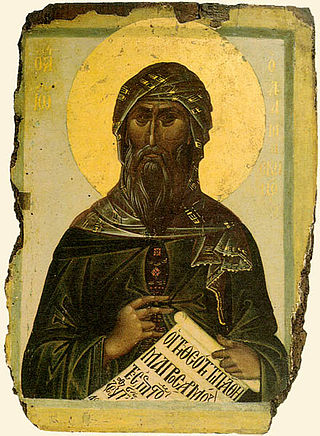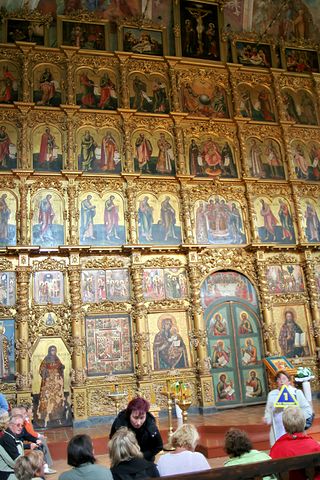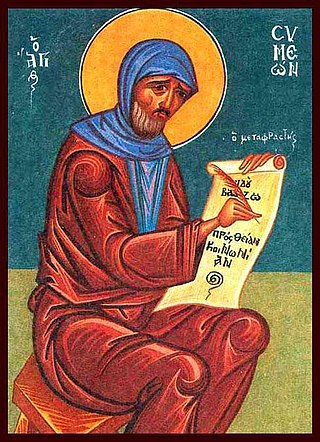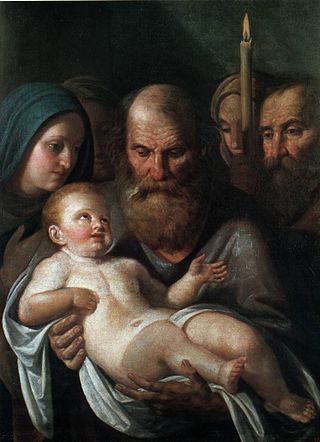
John of Damascus or John Damascene was a Christian monk, priest, hymnographer, and apologist. Born and raised in Damascus c. 675 or 676; the precise date and place of his death is not known, though tradition places it at his monastery, Mar Saba, near Jerusalem on 4 December 749.

The Byzantine Rite, also known as the Greek Rite or the Rite of Constantinople, is a liturgical rite that is identified with the wide range of cultural, devotional, and canonical practices that developed in the Eastern Christian Church of Constantinople.

Synaxarion or Synexarion is the name given in the Eastern Orthodox, Oriental Orthodox and Eastern Catholic Churches to a compilation of hagiographies corresponding roughly to the martyrology of the Roman Church.

Symeon, called Metaphrastes or the Metaphrast, was a Byzantine writer and official. He is regarded as a saint in the Eastern Orthodox Church and his feast day falls on 9 or 28 November. He is best known for his 10-volume Greek menologion, or collection of saints' lives.

Saint Spyridon, Bishop of Trimythous also sometimes written Saint Spiridon is a saint honoured in both the Eastern and Western Christian traditions.

Kaleb, also known as Saint Elesbaan, was King of Aksum, which was situated in modern-day Eritrea and Ethiopia.

Simeon at the Temple is the "just and devout" man of Jerusalem who, according to Luke 2:25–35, met Mary, Joseph, and Jesus as they entered the Temple to fulfill the requirements of the Law of Moses on the 40th day from Jesus' birth, i. e. the presentation of Jesus at the Temple.

Euphemia, known as the All-praised in the Eastern Orthodox Church, was a virgin, who was martyred for her faith at Chalcedon in 303 AD.

The Euchologion is one of the chief liturgical books of the Eastern Orthodox and Byzantine Catholic churches, containing the portions of the services which are said by the bishop, priest, or deacon. The Euchologion roughly corresponds to a combination of the missal, ritual, and pontifical as they are used in Latin liturgical rites. There are several different volumes of the book in use.
The Liturgy of Saint Basil or, more formally, the Divine Liturgy of Saint Basil the Great, is a term for several Eastern Christian celebrations of the Divine Liturgy (Eucharist), or at least several anaphoras, which are named after Basil of Caesarea. Two of these liturgies are in common use today: the one used in the Byzantine Rite ten times a year, and the one ordinarily used by the Coptic Church.

Saint Joseph the Hymnographer was a Greek monk of the ninth century. He is one of the greatest liturgical poets and hymnographers of the Eastern Orthodox Church. He is also known for his confession of the Orthodox Faith in opposition to Iconoclasm.

A liturgical book, or service book, is a book published by the authority of a church body that contains the text and directions for the liturgy of its official religious services.
Minuscule 510, 496, ε 259, is a Greek minuscule manuscript of the New Testament, on parchment. It has been assigned to the 12th century. The manuscript has complex contents. Marginalia are incomplete. It was adapted for liturgical use.

October 24 - Eastern Orthodox liturgical calendar - October 26

The Menologion of Basil II is an illuminated manuscript designed as a church calendar or Eastern Orthodox Church service book (menologion) that was compiled c. 1000 AD, for the Byzantine Emperor Basil II. It contains a synaxarion, a short collection of saints' lives, compiled at Constantinople for liturgical use, and around 430 miniature paintings by eight different artists. It was unusual for a menologion from that era to be so richly painted. It currently resides in the Vatican Library . A full facsimile was produced in 1907.
George of Amastris was a Byzantine monk who was made bishop of Amastris against his will.

Saint Gregory of Dekapolis or Gregory Dekapolites was a 9th-century Byzantine monk, notable for his miracle-working and his travels across the Byzantine world. He is known as "the New Miracle-Worker", and his feast day in the Eastern Orthodox Church and Roman Catholic Church is on November 20.

Callistratusof Carthage and his forty-nine companions were Christian martyrs executed at Rome during the Diocletianic persecution (303–311), now commemorated as saints in the Roman Catholic and Eastern Orthodox churches. Their hagiography, known from the compilation of Symeon the Metaphrast, contains fantastic elements.

Gregory (559–630) was the bishop of Agrigento from 590 until at least 603 and a correspondent of Pope Gregory I. He is the probable subject of two semi-legendary saint's lives and possible author of a commentary on Ecclesiastes, although both of these identifications have been questioned.
Leontius of Damascus was a Syrian monk who wrote a biography in Greek of his teacher, Stephen of Mar Saba. It emphasises Stephen's asceticism and thaumaturgy (miracle-working), but is also a rich source for the history of Palestine in the eighth century. It has been translated into English.















